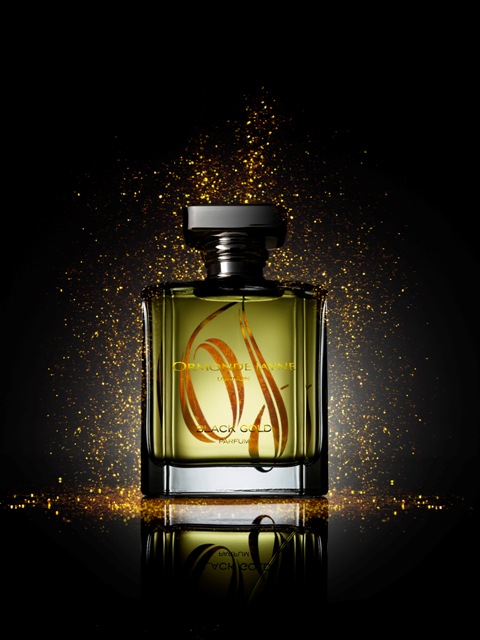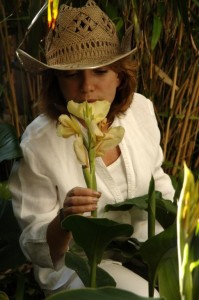Creative Director and Founder Linda Pilkington of Ormonde Jayne in collaboration with Geza Schoen introduces Black Gold, their newest perfume which will be sold exclusively to Harrods. Black Gold is intensely constructed and was years in the making, using costly ingredients from all over the world, which were harvested at their peak and depending on the raw material using hydro distillation and solvent extraction. It is the most luxurious and expensive in the Ormonde Jayne collection.
‘The most important aspect of creating Black Gold was searching for the most absolute ‘absolue’ oils. Finding a quality of sandalwood 20 classes better than other sandalwoods, and that voyage was the lengthiest but the most enjoyable aspect in the creation of Black Gold. Each ingredient was extensively researched and the final perfume was a labour of love.’ – Linda Pilkington
Linda Pilkington
Linda was kind enough to provide an in depth explanation and the details of the processing and origin of the ingredients used in Black Gold
SANDALWOOD
Latin name: Santalum Album L. Also known as Mysore, Sandalwood is a tree native to Eastern India and Western Australia. Crop/Harvest: Despite being harvested all year round, the supply for this oil is outweighed by its demand in the industry. In response to this, the Sandalwood tree is protected to combat actions such young trees being cut down early. It also acts as a major deterrent to the black market of illegally sourced sandalwood oils. Consequently, the price point is costly. Process: Hydro distillation followed by rectification: This is a normal distillation method via steam and water. Rectification process involves a second distillation, in which only those materials at a certain boiling point are collected – thus purifying the oil. It yields a superior aroma. Yield: 1 kg is made from about 20 kg of wood
CARNATION ABSOLUTE
Latin name: Dianthus caryophillus L. It is said that each colour represents a different meaning. This absolute oil is a member of the floral green family, with spicy and waxy notes. Origin: Egypt; Crop/harvest: March-May;Processed part: Flowers. Process: Solvent extraction followed by purification with ethyl alcohol. Using a solvent that does not mix with water, second stage is extraction with ethanol because of the amount of wax. A long and complicated process to protect the integrity of Absolute.Yield: 1 kg is made from about 2500 kg of flowers.
AMBRETTE ABSOLUTE
Latin Name: Hibiscus Abelmoschus L.Ambrette is a hibiscus plant. 2m tall and more common in India and the Middle East. Ecuador and Peru have also become major suppliers to the industry. The Absolute produced is a member of the powdery family with musky notes. Origin: Ecuador and Peru; Crop: May-June; Processed: Part seeds; Process: Hydro distillation followed by purification, a process which is the same as Hydro distillation followed by rectification. Purification process involves a second distillation in which only those materials at a certain boiling point are collected, therefore purifying the oil. Superior aroma yield is obtained via this method but is lengthy and costly.Yield: 1 kg is made from about 500 kg of seeds
SCHINUS MOLLE
Latin name: Schinus molle L. Schinus Molle is a tree native to the Peruvian Andes. The pink berries grown on the tree are often sold as "pink peppercorn". The oil produced is a member of the spicy family with fruity, peppery and woody notes. Origin: Ecuador and Peru. Crop/Harvest: Jun- Aug; Processed part: Berries;Process: Hydro distillation. Distillation method via steam and water. Yield: 1 kg is made from about 20 kg of seeds
LABDANUM RESINOID MD
Latin Name: Cistus Ladaniferus L. Labdanum is a resin obtained from a species of plants called Rock Rose. Native to the Mediterranean. Origin: Spain; Crop: Jun-Sep; Processed part: Gum-resin. Process: Extraction with ethyl alcohol followed by molecular distillation.This is a highly complex extraction method and is a compromise between solvent extraction and distillation. Ethanol is used to extract the resin along with all the water. This is then distilled further to remove the ethanol and water molecules to ensure that only the pure resin remains. Yield: 1 kg is made from about 16 kg of resin
Top: bergamot, lemon, mandarine, clary sage, juniper berry
Heart: orchids, rose, water lilies, jasmine, carnation absolute
Base: oudh, schinus molle, sandalwood, patchouli, vetiver, vanilla, labdanum, moss, musk, cedar, ambrette seed, amber
Price: £420 / 120ml eau de parfum (poured at 50%)
Available exclusively from Harrods and Harrods.com
-via Linda and Ormonde Jayne PR


